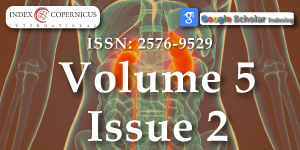Acute Kidney Injury due to spontaneous Atheroembolic disease, superimposed on diabetic nephropathy, with no recent vascular or cardiac intervention, presented as Rapidly Progressive Glomerulonephritis (RPGN)
Main Article Content
Article Details
Copyright (c) 2021 Diab A, et al.

This work is licensed under a Creative Commons Attribution 4.0 International License.
The Journal of Clinical Nephrology is committed in making it easier for people to share and build upon the work of others while maintaining consistency with the rules of copyright. In order to use the Open Access paradigm to the maximum extent in true terms as free of charge online access along with usage right, we grant usage rights through the use of specific Creative Commons license.
License: Copyright © 2017 - 2025 |  Open Access by Journal of Clinical Nephrology is licensed under a Creative Commons Attribution 4.0 International License. Based on a work at Heighten Science Publications Inc.
Open Access by Journal of Clinical Nephrology is licensed under a Creative Commons Attribution 4.0 International License. Based on a work at Heighten Science Publications Inc.
With this license, the authors are allowed that after publishing with the journal, they can share their research by posting a free draft copy of their article to any repository or website.
Compliance 'CC BY' license helps in:
| Permission to read and download | ✓ |
| Permission to display in a repository | ✓ |
| Permission to translate | ✓ |
| Commercial uses of manuscript | ✓ |
'CC' stands for Creative Commons license. 'BY' symbolizes that users have provided attribution to the creator that the published manuscripts can be used or shared. This license allows for redistribution, commercial and non-commercial, as long as it is passed along unchanged and in whole, with credit to the author.
Please take in notification that Creative Commons user licenses are non-revocable. We recommend authors to check if their funding body requires a specific license.
Kronzon I, Saric M. Cholesterol embolization syndrome. Circulation 2010; 122: 631-641. PubMed: https://pubmed.ncbi.nlm.nih.gov/20697039/
Tanaka H, Yamana H, Matsui H, Fushimi K, Yasunaga H, et al. Proportion and risk factors of cholesterol crystal embolization after cardiovascular procedures: a retrospective national database study. Heart Vessels 2020; 35:1250-1255. PubMed: https://pubmed.ncbi.nlm.nih.gov/32277287/
Nickol J, Richards T, Mullins J. Cholesterol Embolization Syndrome From Penetrating Aortic Ulcer. Cureus 2020; 12: e8670. PubMed: https://www.ncbi.nlm.nih.gov/pmc/articles/PMC7370687/
Muller-Hansma AHG, Daemen-Gubbels CRGM, Schut NH. Cholesterol embolisms as possible adverse drug reaction of direct oral anticoagulants. Neth J Med 2018; 76:125-128. PubMed: https://pubmed.ncbi.nlm.nih.gov/29667588/
Scolari F, Ravani P. Atheroembolic renal disease. Lancet 2010; 375: 1650-1660. PubMed: https://pubmed.ncbi.nlm.nih.gov/20381857/
Cosio FG, Zager RA, Sharma HM. Atheroembolic renal disease causes hypocomplementaemia. Lancet 1985; 2: 118-121. PubMed: https://pubmed.ncbi.nlm.nih.gov/2862317/
Ridker PM, Cannon CP, Morrow D, Rifai N, Rose LM, et al. C-reactive protein levels and outcomes after statin therapy. N Engl J Med. 2005; 352: 20-28. PubMed: https://pubmed.ncbi.nlm.nih.gov/15635109/
Vaidya PN, Finnigan NA. Atheroembolic Kidney Disease. 2021. PubMed: https://pubmed.ncbi.nlm.nih.gov/29494024/
Matsumura T, Matsumoto A, Ohno M, Suzuki S, Ohta M, et al. A case of cholesterol embolism confirmed by skin biopsy and successfully treated with statins and steroids. Am J Med Sci 2006; 331: 280-283. PubMed: https://pubmed.ncbi.nlm.nih.gov/16702800/

